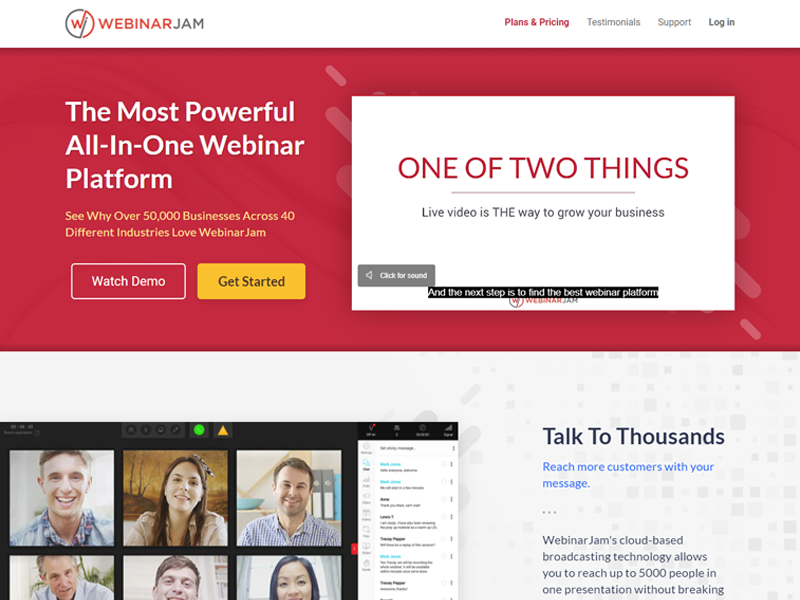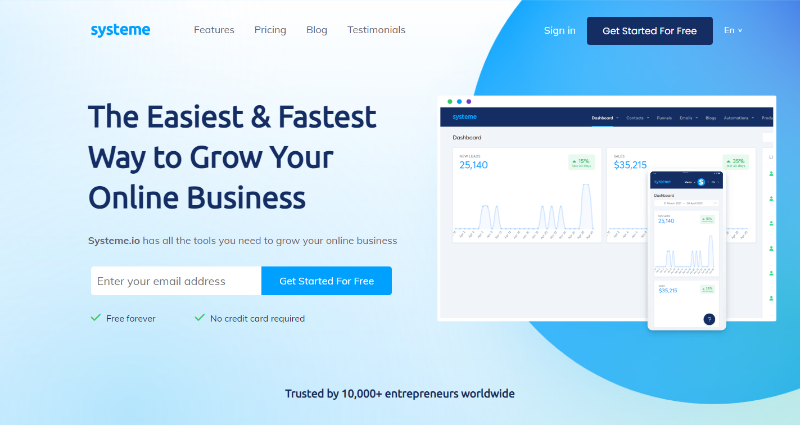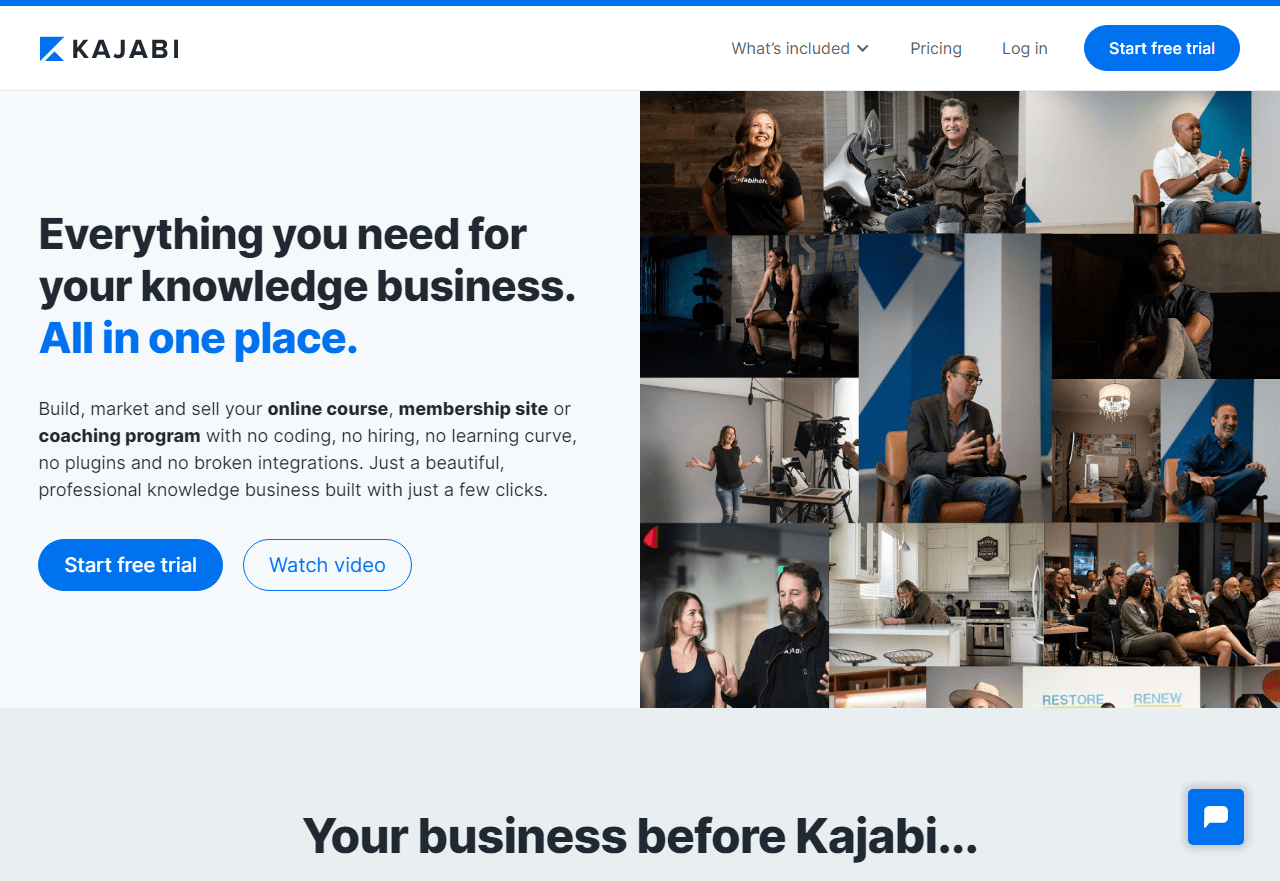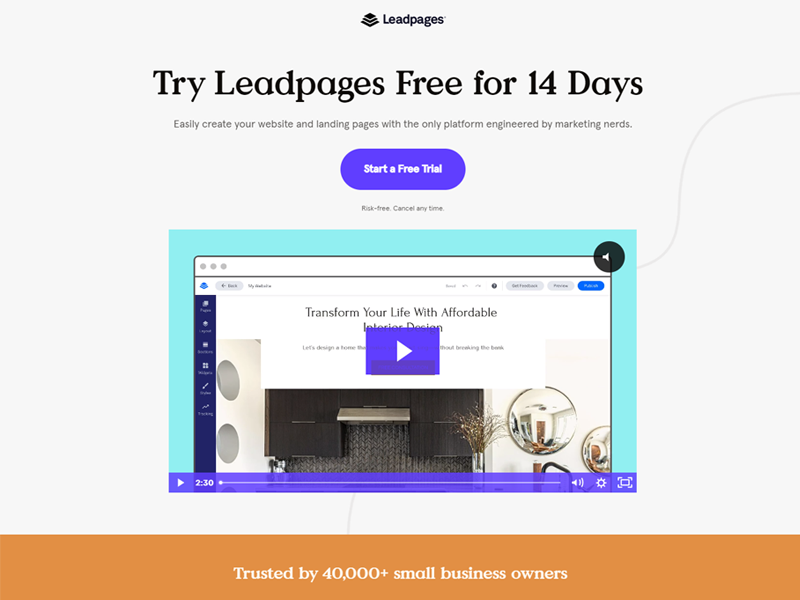Webinars are a great sales funnel and marketing strategy that can help reach a new audience and grow your target customers.
They could be in the form of online workshops, virtual training, or live classes. Several webinar software platforms can be used to organize webinars. Some of these platforms are free to use and don’t require any technological expertise.
Many prominent brands have adopted webinars to promote productivity for their organization. Understanding the impact of webinars in the corporate world can help you see the various benefits it provides to your business.
This article will discuss some exciting webinar stats and the impacts in today’s corporate world.
Key Webinar Statistics
- The average registration number of a webinar is around 260.
- 73% of B2B marketers consider webinars as a highly effective tool for generating quality leads.
- 20-40% of webinar attendees are going to turn into qualified leads.
- 61% of marketers use webinars as a tactic for their content marketing strategy.
- 60-minute webinars attract more attendees than 30-minute webinars.
- Webinars that feature video in the presentation rated a 7.8/10
- A single webinar could get you over 1,000 leads.
- 54% of attendees sign-up eight days before a webinar launches.
General Webinar Statistics
The COVID-19 Pandemic in 2020 had a great impact on workplace operations. A significant effect is a current shift in remote and online jobs. This has also impacted the need for more webinars to be organized in the workplace. Here we will be discussing some general webinar statistics that show the impact of webinars in the workplace.
1. Most marketers agree that webinars are vital tools.
(on24.com, bloggingX)
Webinars are a favorite tool for marketers, thanks to the ease they bring to communication. According to webinar statistics on how marketers view webinars, about 95% of respondents agree that webinars are essential for their marketing efforts. They further rated webinars 3.08 points on a scale of one to five concerning how useful webinars are to digital communications.
2. According to customers, the most valuable addition to webinars is on-demand viewing.
(BrightTalk)
Customers prefer flexible viewing experiences when it comes to additional functionalities. Webinar marketing statistics from BrightTalk reveal that viewers also love receiving slides together with on-demand viewing during a presentation. They value the “watch later” functionality and enjoy downloading additional resources.
3. About 58% of marketers depend on webinars for promotion.
(OptinMonster)
Webinar statistics reveal that 58% of marketers see webinars as a promotion tool. They rely on it for many of their sales. Interestingly, studies show that about 2% and 5% of webinar attendees eventually purchase a product at the end of a webinar.
4. Around 89% of marketers agree that webinars outperform other channels of creating qualified leads.
(Business Wire)
Most industries use webinars as a tool for generating leads. Webinar lead generation statistics show that about 66% of businesses agree that their sales teams rate leads coming from webinars highly. About 79% state that there’s a direct influence of webinars on revenue and pipeline. A further 78% confirm that webinars help lower the cost per lead.
5. Use of webinars and virtual events among B2B marketers increased from 57% to 67%.
(CMI B2B Report, CMI B2C Report)
Surveys on webinars have revealed that B2B marketers depend more on webinars and other virtual events than their B2C counterparts. It further told that around 67% of B2B companies have at some point hosted webinars, compared to only 39% of B2C businesses. These B2B webinar statistics show that B2B companies rate webinars, virtual events, online courses, blog posts, and short articles as the most performing content marketing channels.
6. When hosting a webinar, about 33% of marketers prioritize using interactive tools.
(BrightTalk, Marketing Impact Report)
The use of digital technology peaked during the COVID-19 pandemic. As professionals embrace a hybrid system of in-person and online workflow, the use of digital technology hit an all-time high. Statistics show that around 56% of professionals agreed to spend more than four hours daily interacting with people digitally. This makes engaging and quality content more useful than ever.
Interestingly, marketers have always searched for the best practices for webinars that will make them stand out among the crowd and break away from the noise. Webinar statistics show that most marketers prefer to improve audience interaction through polls, questions, and votes. About 28% of them prefer to enhance audience interaction by simplicity and ease of use, while 27% prefer flexible formats.
7. About 57% of marketers run about 50 webinars yearly.
(on24.com)
Statistics from on24.com show that around 29% of marketers run up to 100 webinars yearly. However, an average of 57% of marketers run about 50 webinars yearly. This percentage is satisfactory and shows how valuable webinars are for marketers.
Statistics further reveal that 80% of organizations hosting training webinars organize up to 100 webinars yearly. On the other hand, a webinar benchmarks report states that about 93% of webinars for continuing education are run at least 150 times per year.
8. The pharmaceutical industry has the highest webinar live attendance rate of 63%.
(Livestorm)
Webinar marketing statistics from Livestorm reveal that the average webinar attendance rate is 46%. The pharmaceutical industry has the highest webinar live attendance rate of 63%. The financial services sector has the second-highest attendance rates, at an average of 61%. The consulting industry follows them with an attendance rate of 50%.
Other sectors with relatively high attendance rates are the SaaS, advertising industry, and some companies developing webinar software. They have an attendance rate of 46%, 33%, and 30%, respectively.
9. Around 93% of webinar participants attend with desktops.
(MegaMeeting)
Statistics show that about 93% of webinar attendees use traditional desktops to connect, while only 7% use tablets or mobiles. Out of the desktop users, around 80% attend webinars with desktops running on Windows. The other 20% run on Android, Mac, or iOS.
10. The average cost to organize webinars ranges from $3,500 to $5,000.
(My Own Conference, Workcast)
Webinar budgets are affected by several key factors such as staff strength, cost of equipment, software, and promotions. Statistics show that the average cost of organizing webinars ranges from $3,500 to $5,000. Experts suggest spending 40% to 60% of the allocated budget on promotional efforts, although promotional costs varies greatly.
Game-Changing Webinar Facts And Statistics
Webinars have impacted the way businesses are run in today’s world. Here, we will look at some game-changing webinar facts and statistics.
11. Around 24% of all webinar registrations are done on a Tuesday.
(GoToMeeting)
Tuesdays rank highest for days with the most webinar registrations. About 24% of all webinar registrations are done on a Tuesday. Thursdays and Wednesdays are next after Tuesdays with 16% and 15% registrations, respectively. Saturdays and Sundays rank the least.
12. The most effective webinar promotion tool remains email.
(GoToMeeting, Inc.com)
Emails are free tools ranked as the most effective webinar promotion tool. This is most likely because it is free. Emails provide a great way to promote any event. According to recent surveys, the solicitations through email account for about 73% of webinar signups.
However, company websites and blogs account for up to 14% of the registrations. Although most marketers prefer using emails, they still exploit the company website and blog. GoToMeeting's webinar attendance statistics further indicate that LinkedIn, Twitter, Facebook, or other social media could help get up to 15% of webinar registrations.
13. Attendance is increased by 20% when reminder emails are sent on the event day.
(GoToWebinar, Webinars for Dummies)
Planning an event can be tedious, and if not correctly designed, attendance could be poor. To void poor attendance, sending reminder emails can help. Statistics show that attendance increases by 20% when reminder emails are sent on the day of the event. However, many marketers may overlook sending reminder emails on the day of the event and focus more on promotional emails sent the previous week.
Based on that, webinar statistics reveal that the best time of the day for sending promotional emails would be between 8 a.m. and 12 p.m. To score more points, aim for the “happy hour” of webinar registrations which is 9 a.m. statistics show that promotional emails sent around 9 a.m. have a 14% success rate. In addition, investing in email marketing software to automate your messages is a wise choice, as it helps attract and keep people’s attention.
14. About half of the webinar attendees sign up a week or more before the webinar.
(Marketing Charts)
According to a report from Marketing Charts, the best time to be announced webinars is two weeks or even earlier before the official date. This gives room for good promotional campaigns—the chances of having better results come with a more excellent promotional cycle. Webinar effectiveness statistics reveal that about 47% of attendees register for webinars at least eight days before the webinar date. On the other hand, about 24% of attendees sign up two weeks earlier or more.
15. Thursdays are the best days to host webinars.
(MegaMeeting)
Although Tuesdays have the highest rate for webinar invitations, Thursdays are the best days to host webinars with a rate of 19%. Mondays are one of the worst days to hold webinars as they are generally busy workdays. Wednesdays come next as a good choice holding webinars after Thursdays with 18%. Interestingly, webinar attendance statistics reveal that webinars held any day between Tuesdays and Thursdays are good for getting the needed.
16. The prime times are for hosting a webinar 2, 3, and 4 p.m.
(Click Meeting)
Webinars are unique because it allows you can connect to people from different parts of the globe, irrespective of the time zone difference. However, setting the best time to host a webinar is essential. This can be somewhat tricky due to time zones differences. Webinar statistics reveal that the best time to hold webinars to accommodate viewers from various time zones is the afternoon. The prime times are for hosting a webinar 2, 3, and 4 p.m.
17. 30-minute webinars attract fewer attendees than 60-minute webinars.
(WorkCast)
The general belief is that one hour is the optimal duration for webinars. Statistics show that webinars that last for one hour attract more attendees than those for half an hour. Interestingly, some reports suggest that longer webinars attract more crowds.
This implies that 90-minute webinars are more suitable for presentations or training with attendees who want to broaden their knowledge. However, 15 to 20-minute webinars produce great results for start-ups aiming to integrate these short webinars more frequently.
18. Webinars that are too marketing-focused put off 78% of buyers.
(BrightTalk)
There are several reasons why buyers may not register for a virtual event. However, webinar statistics show that too product-oriented or marketing-focused events put off about 78% of buyers. This could be the primary reason for audience dissatisfaction. Also, about 56% of buyers complain about content length, depth misalignment, and presenters lacking relevance or authority.
19. Practitioners have the highest webinar conversion rates of about 53% on all job levels.
(BrightTalk)
Practitioners have the highest webinar conversion rates at 53%, followed by directors at 50%. The following line is managers and upper management like C-level professionals and VP. They both tie at 46%.
20. Communication webinars hold the record for the highest conversion rate at 67.05%.
(BloggingX)
The highest webinar conversion rate is 67.05% and is held by communication webinars. Training webinars are next in line with a rate of 44.79%. Marketing webinars come third with 39.10%. Interestingly, education-oriented webinars have the lowest registrant-to-attendee conversion rate. According to webinar conversion stats, education-oriented webinars have a rate of 30.79%, although they are still growing in popularity.
21. Around 48% of B2B marketers agree that webinars produce better results with their lead nurturing initiatives.
(Demand Gen Report)
About 48% of marketers believe that webinars provide the most effective way to nurture leads, as they show technical compatibility and expertise on the subject matter. Thought leadership articles, email newsletters, and customer content like case studies and reviews are other content types used within lead nurturing programs. About 41% of marketers agree on thought leadership articles, 40% agree on email newsletters, and 39% agree on customer content.
22. Around 51% of marketers assess a webinar’s success with demand metrics.
(BrightTalk)
Research shows that most marketers rely more on demand metrics to assess the event's success when putting together webinar metrics together compared to content engagement data. According to webinar engagement statistics, demand metrics are further broken down: lead quality with 23%, pipeline conversion with 16%, and lead volume with 12%.
23. After a webinar, about 62% of buyers will request a demo from sales.
(BrightTalk)
Statistics show that about 62% of buyers are likely to request a demo from the sales team after a webinar. However, after webinar review, about 89% will further check the vendor’s website for additional content. Statistics show that around 86% of buyers tend to download resources or attachments, 80% view a competitor's content and 83% share content with their colleagues.
24. About 81% of webinars use Q&As.
(on24.com)
Questions and answers are the foundation of webinar engagement tools and remain the all-time favorite webinar engagement tool. Reports from on24.com show that about 81% of webinars use Q&As, while 92% of attendees expect a live Q&A session towards the end of a webinar.
Live Q&As are ranked high as successful webinar engagement tools because they offer a fun way for the attendees and the presenter to interact. About 69% of webinars provide downloadable resources to engage their attendees. More webinar engagement statistics show that media, surveys, and polls are adequate engagement tools.
25. Webinars with videos are highly rated, with 7.8 out of 10.
(bloggingX)
To make your webinars more engaging and compelling, it is best to integrate videos into them. With this, your viewing time will ultimately scale up. Interestingly, 32% of webinar hosts don’t use videos in their webinars. They say they lack the skills to integrate videos in their presentation, while about 27% say integrating videos in webinars is too expensive.
26. Always-on webinars have increased in popularity by 36%.
(on24.com)
According to webinar watch stats, live broadcasts are the most favored type of webinar with about 59% ratings. However, always-on-only webinars are gradually gaining traction as they are more convenient for registrants to access. Interestingly, live, and always-on webinars are ranked low at 5%.
27. According to webinar trends, 79% of webinar data is video.
(MegaMeeting)
The average bandwidth used for an attendee or a host connection to a webinar is around 380Kbps. Knowing that the proper connection is critical for a high-quality video is essential. Statistics show that about 79% of the data shared in a webinar is video, while only 21% is audio.
The Importance Of Webinars
If you are a blogger, marketer, entrepreneur or business owner, you can’t deny that webinar is important for smooth running of your day-to-day activities. Here, we will discuss the importance of webinars.
28. About 95% of companies agree that webinars are practical tools to achieving their business goals.
(On24)
Webinars have become essential tools for business growth over the years. Statistics show that about 95% of all entrepreneurs and businesses surveyed understand the importance of webinars. They believe that webinars put them on the right path to achieve their goals.
29. From 2019 to 2021, Zoom searches on the internet doubled.
(Google Trends)
Zoom remains one of the most potent webinar tools online. It is one of the favorite webinar platforms most hosts use. As a result, the Google searches for Zoom doubled from 2019 to 2021. It also increased in revenue by over 317% from 2019 to 2020. The massive increase experienced can be attributed to the effect of the pandemic, which has affected the company positively.
30. Most company now give their internal training through webinars.
(Visionogy)
Organizing webinars has always been a thing for companies when educating or informing their customers about their products. However, the pandemic has impacted the way many companies hold internal training. Most companies now see the benefits of providing internal training through webinars.
It gives them the option to educate their customers and their internal teams. This allows for better relationships with customers, company knowledge, higher employee satisfaction, and business growth. There are also several reasons why most companies have now turned to webinars for training purposes.
Webinars For Business Objectives
Taking advantage of the opportunities webinars present will help improve your business’ productivity. Here, we will look at stats that show how webinars impact business objectives.
31. About 60% of webinars focus on nurturing relationships with loyal customers.
(On24)
Building relationships is essential for any business to succeed. However, to build a strong business relationship, one must first have the chance to interact with loyal and potential customers. Based on this, about 60% of webinars focus on nurturing relationships with loyal customers. This will also lead to growth in the company’s community and online presence.
32. Eight out of every ten marketing websites drive their webinar registrations through their site.
(Statista)
A high webinar registration rate indicates a higher attendance possibility. However, getting people to register for a webinar can be challenging. One has to be strategic about it, as you can’t just paste a registration link anywhere. Based on this, 80% of marketing websites drive their webinar registrations through their site.
33. Almost 30% of webinar attendees attend webinars registered for on the day of the event.
(WebinarCare)
Preparing for webinars weeks before the main event is key to increasing attendance. However, statistics show that offering attendees the chance to attend a webinar on the same day they register affects attendance positively. This is based on people’s need for instant gratification. Many webinar attendees expect the event to be ready when they’re ready to attend. Statistics show that almost 30% of webinar attendees attend webinars registered for the day of the event.
34. Business-to-consumer presentations have a webinar attendee conversion rate of 20 to 40%.
(WebinarCare)
Statistics from WebinarCare show that business-to-consumer presentations have a webinar attendee conversion rate of 20 to 40%. Having a high webinar attendee conversion rate is crucial for the success of any business. The higher the speed, the attendance for the event. The higher the attendance, the more people take action on your message.
On the other hand, having a low webinar attendee conversion rate for your event indicates that you need to improve some areas of your webinar marketing. Having professional digital marketing strategies will help strengthen your webinar conversion rate.
35. The optimal length of most webinar registration forms ranges between five and six pages.
(WebinarCare)
Signing up for a webinar sometimes takes time. However, many attendees are put off by the webinar registration page with too much information. Therefore, making your registration page message as straightforward as possible is essential. Surveys suggest that the optimal length of most webinar registration forms ranges between five and six pages.
Conclusion
Webinars are turning out to become the new blogs. Their flexibility has helped many businesses, entrepreneurs, and independent coaches promote their services, generate qualified leads, improve sales and increase attendance ratings. The webinar marketing statistics discussed in this article should better understand what it takes to create a practical webinar. However, keep things simple and stick to what works for you when hosting a webinar.
References:
- https://communications.on24.com/rs/848-AHN-047/images/on24_benchmarks_assessment.pdf
- https://optinmonster.com/webinar-marketing-101-how-to-sell-anything-with-webinars/
- https://contentmarketinginstitute.com/wp-content/uploads/2021/01/b2c-research-report-2021.pdf
- https://www.megameeting.com/news/webinar-statistics-2019/
- https://www.goto.com/blog/7-webinar-scheduling-secrets
- https://assets.cdngetgo.com/e7/73/cbeb606b4f9295747b31e0442f24/gotowebinar-2017-big-book-of-webinar-stats.pdf
- https://uploads-ssl.webflow.com/60ad434763cd9b000903a8eb/60bec8c9cbd976409d97ee7a_brighttalk-2020-q3-marketing-impact-report-ebook.pdf
- https://knowledge.clickmeeting.com/infographic/state-webinars-2020/
- https://bloggingx.com/webinar-statistics/
- https://www.businesswire.com/news/home/20210602005035/en/Global-Report-Shows-Use-of-Webinars-Triples-Driving-Digital-First-Engagement-Across-Industries
- https://uploads-ssl.webflow.com/60ad434763cd9b000903a8eb/60bec8c9cbd976409d97ee7a_brighttalk-2020-q3-marketing-impact-report-ebook.pdf
- https://myownconference.com/blog/en/how-much-does-it-cost-to-host-webinar/
- https://blog.workcast.com/whats-the-optimum-length-of-a-webinar
- https://livestorm.co/webinar-statistics
Ludjon, who co-founded Codeless, possesses a deep passion for technology and the web. With over a decade of experience in constructing websites and developing widely-used WordPress themes, Ludjon has established himself as an accomplished expert in the field.









Comments